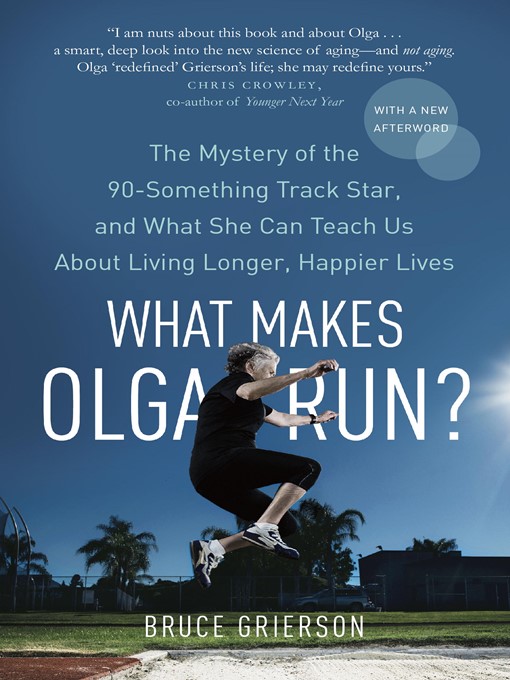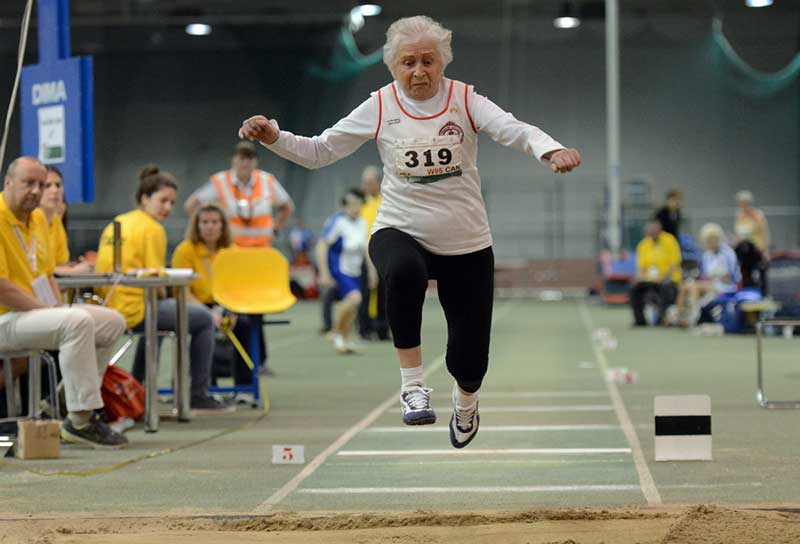“Time and trouble will tame an advanced young woman, but an advanced old woman is uncontrollable by any earthly force.” ~Dorothy L. Sayers
Olga Kotelko is a track and field prodigy.
At age 95, she competed in eleven sports—long jump, high jump, triple jump, shot put, discus, javelin, hammer throw, 100-meter, 200-meter and 400-meter sprints, and the 4 x 100-meter relay.
She held more than 30 world records and won more than 750 gold medals in her age category.
At the 2009 World Masters Athletics Championships in Finland, Olga threw a javelin almost twenty feet farther than her closest competitor.
Olga has inspired me to rethink the whole idea of late-blooming. We reserve the word prodigy for the young. But it has much broader meaning.
My favorite definition, from the Oxford English Dictionary, is “an amazing or unusual thing, especially one out of the ordinary course of nature.”
Anyone can be a prodigy at any age. And Later Bloomers, especially, deviate from the ordinary course of nature.
Olga Kotelko: Her Harrowing Early Years
In his book What Makes Olga Run? Bruce Grierson describes Olga’s ordinary but remarkable early life.
She was born, the seventh of eleven children, on March 2, 1919, to Ukrainian wheat farmers who settled in the hamlet of Smuts in Saskatchewan. She routinely milked cows at dawn, walked three miles to school, and scrubbed fifteen sets of clothes on a washboard.
She first displayed her remarkable hardiness at six-weeks-old. Her parents loaded their brood onto a horse-drawn sleigh to get baby Olga baptized at the local Ukrainian Catholic church.
Along the way, the tightly-swaddled Olga rolled off the sleigh. The family traveled a full mile before realizing the infant was missing. They doubled-back and found her at the side of the road, unperturbed and unharmed.
At age 22, Olga began teaching grades one through ten in a one-room schoolhouse. She met John, a handsome insurance salesman, at a dance. They soon married.
He turned out to be an alcoholic philanderer. In the 1950s, a woman on the Canadian prairie (or anywhere) didn’t just up and divorce her husband. Olga stayed for a decade.
One night, in a drunken rage, John put a knife to her throat. Olga, pregnant with their second child, fled into the cold with her 8-year-old daughter.
They jumped a train to Vancouver and ended up at her sister’s doorstep. “As far as I knew,” Olga recalls, “I was the first single mom in the history of the world.”

How Did Olga Slow the Aging Process?
Olga lived with her sister for a few years, found a factory job, and studied at night for her teaching credential.
She taught school for 34 years until her mandatory retirement. She was so well-loved that her first-grade students from the class of 1960 took her to dinner each year from 2005 on.
To keep busy after retiring, Olga played slow-pitch softball (something she’d enjoyed as a girl) but grew bored. Track and field offered a bigger running-and-throwing challenge.
At age 77, Olga hired a coach, one of several who would guide her path. In 1999, she entered her first World Masters competition in Gateshead, England, where she broke two world records and won six gold medals.
Her athletic success soon drew media attention, and several universities tried to discover her secret. They stuck her with needles, hooked her up to electrodes, and ran her over on virtual reality highways.
“She functions more like a very healthy 70-year-old than a 93-year-old,” McGill University physiologist Russ Hepple observed.
The studies confirmed that something had slowed Olga’s aging process, not just physically, but mentally. Yet several years passed before someone uncovered a clue.
Olga Kotelko’s “Secrets”
Although Dr. Aga Burzynska arrived at the University of Illinois just a month after Olga tested there, they never met. But she feels like Olga is an old friend.
After months of studying thousands of MRIs and comparing them to Olga’s, Dr. Burzynska discovered what made Olga Kotelko’s brain unique: The extraordinary development of the “white matter” in her corpus callosum.
White matter is composed of axons and myelin, which facilitate brain communication and nerve signal speed respectively.
The corpus callosum is a thick band of fibers between our left and right hemispheres. It’s the brain’s communication superhighway, moving information between the two regions.
Dr. Burzynska’s studies posit that Olga’s late-blooming physical activity gave her an extra-efficient superhighway.
Olga’s “can-do” attitude also helped slow her aging. After following her for four years, Bruce Grierson distilled Olga’s “secret” into the following:
1. Keep Moving. Any block, creative or otherwise, can be solved with movement. When we move, our bodies and brains become dance partners. If you’re a writer, take a walk outside, let your hand flow across a piece of paper, do one then the other—just keep moving.
2. Create Routines (But Sometimes Break Them). Our bodies crave routine. It frees our minds for art, storytelling, and exploration. But if we occasionally break routine, we jolt our bodies and brains out of lazy shortcuts and force them to adapt.
3. Believe in Something. It doesn’t matter what. Olga was devoutly religious, but she also believed in the wonders of massage and reflexology. Believing in yourself eclipses everything else.
4. Begin Now. Here’s Bruce Grierson’s observation on boomers: “We’re rested, we’re restless, we’re ready.” A perfect prescription for beginning that creative project you’ve been putting off. Here’s an archive of people who started their “thing” after age 50 to inspire you!
5. Cultivate a Sense of Progress. I use Jen Louden’s Conditions of Enoughness to create a container around my activities. They’re the best way I’ve discovered to feel good about my creative progress. In a nutshell, she says:
- Be realistic about your goal.
- Set a time element.
- Ensure it’s doable by YOU alone on an AVERAGE day. (Not a waggle of wizards in a cosmic lifetime.)
- And most importantly, declare it enough when you meet your conditions. Celebrate your smallest wins! They’re amuse-bouche for your brain.

Olga’s Legacy
On June 14, 2014, at age 95, Olga Kotelko passed away when a large blood vessel ruptured in her brain. Her doctors say she lost consciousness immediately and didn’t suffer. In her last World Master appearance a few months before, she won ten gold medals.
Bruce Grierson noted that her death, though premature and shocking, was “the perfect way to go out. She left nothing significant undone or undreamed.”
At the risk of sounding cliché, it’s never too late to become a prodigy—an amazing, unusual thing out of the ordinary course of nature, an advanced and uncontrollable old woman (or man). Why?
As Olga Kotelko puts it, “To inspire, that’s the name of the game.” And of course, she didn’t just walk her talk, she ran it, right to the end.
Sources
- Opening photo: Grant Harder for Parade
- An earlier version of this article first appeared on Kathy Pooler’s excellent blog and resource, Memoir Writer’s Journey.
- Curious about Olga’s training routine? You can read about it here.
- And definitely, check out What Makes Olga Run? by Bruce Grierson
